The Dell XPS 13 7390 2-in-1 Review: The Ice Lake Cometh
by Brett Howse on November 15, 2019 11:30 AM ESTDisplay Analysis
Dell offers two display options. The review unit arrived with the first option: a 1920x1200 sRGB display, offering pen and touch support. Dell also offers a 3840x2400 P3-D65 panel, which delivers a higher resolution image with a wider color gamut, but as we've seen time and time again, will come with a stiff hit to battery life. Both feature bonded Corning Gorilla Glass 5 as well, for added durability. In addition, the displays feature a good anti-reflective coating, which is rated at 0.65% reflectivity. This means more viewing of what’s on the display, and less viewing of what’s in the room.
The move back to a taller screen provides a lot of benefits in the laptop space, where doing work often involves the vertical axis. Scrolling spreadsheets or webpages are two basic examples of an added benefit of more vertical pixels, and while it may not seem like a big change to go from 16:9 like most laptops to 16:10, in use it is a very welcome change. It also eliminates the large chin found on the bottom of most laptop displays, and Dell has stretched out the 13.3-inch on the outgoing XPS 13 to a slightly larger 13.4 in the same footprint, without increasing the size of the laptop itself.
The base display offers 169 pixels-per-inch (PPI) pixel density, which, while still well above the standard 92 PPI of old, doesn’t match the Surface Laptop 3, as an example. But it still offers plenty of resolution for most tasks, and with the added benefit of offering better battery life. But if you do want lots of PPI the 4K option will of course double the PPI to 338, at the cost of money and battery life.
Dell also offers Dolby Vision on both panels, but Dolby Vision on laptops is not what you may think. It will support Dolby Vision video playback in Netflix, but it doesn’t transform the display into an HDR offering. It just works to provide the best picture it can with the hardware available. On the 4K panel though, Dell is offering P3-D65 gamut support as well as HDR 400 certification. It should be a fantastic display in certain scenarios, but be warned that Windows is fairly hamstrung on support for HDR, and especially wide-gamut displays, since its color management is fairly limited.
To see how the display performed, we tested it with Portrait Display’s SpectraCal software with a custom workflow. Brightness and contrast were measured with the X-Rite i1Display Pro colorimeter, and color accuracy was tested with the X-Rite i1Pro2 spectrophotometer.
Brightness and Contrast
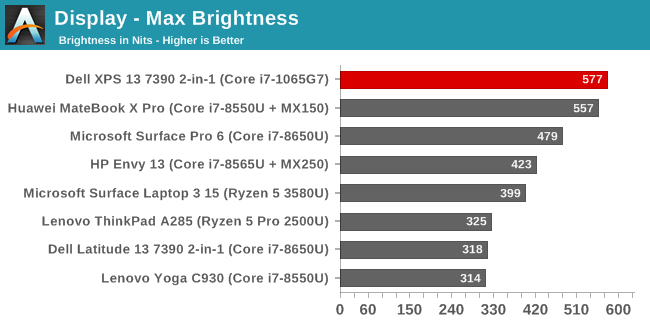
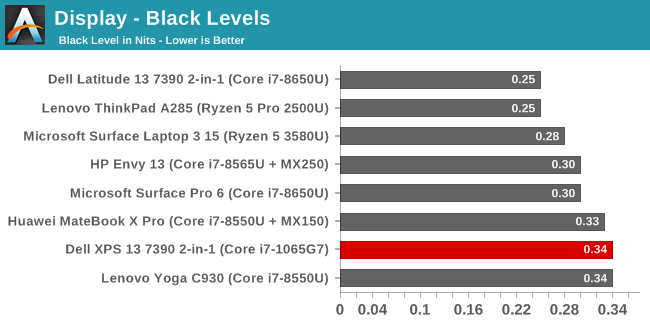
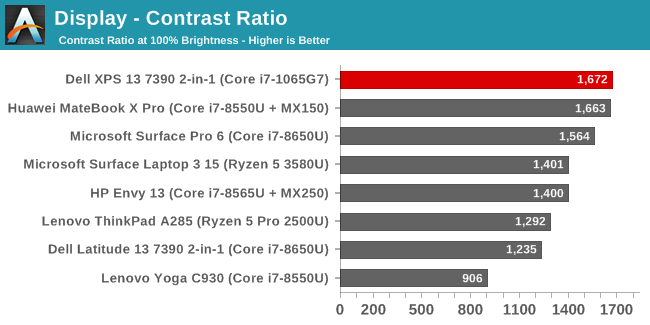
The XPS 13 can get exceptionally bright, closing in on 600 nits, while at the same time offering almost 1700:1 contrast ratio. These are fantastic results for a laptop, and especially one that is this portable since it should work well even under bright conditions. If it had a downside, it would be that the display only dims to 27 nits (white), which is far too bright to use as a tablet in bed.
Grayscale
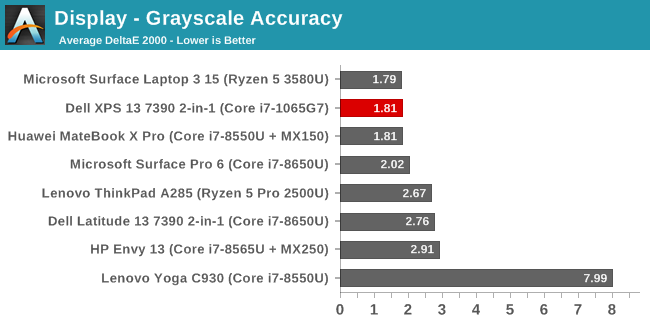
Dell has upped their game significantly with the XPS 13 7390. Clearly they’ve employed some color calibration, since the display’s grayscale accuracy is almost perfect, with no error levels over 3.0, and a gamma that closely matches the 2.2 target. The display is slightly cool in its white point, but overall it is a great result.
Gamut
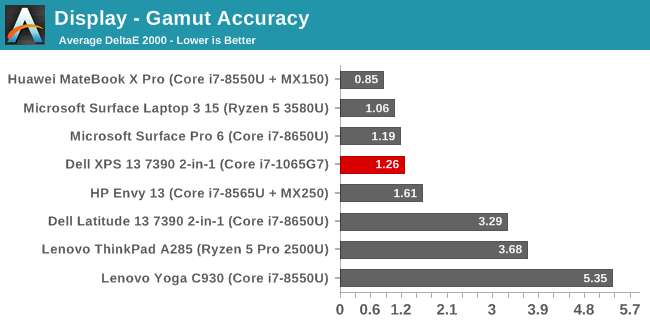
Testing the display at 100% levels for the primary and secondary colors shows that Dell has taken their color seriously on this laptop. It pretty much perfectly matches the sRGB color gamut, with great accuracy on all of the colors. All of the results are well under the 3.0 level we consider to be accurate, and most are under the 1.0 level we’d consider imperceptible.
Saturation
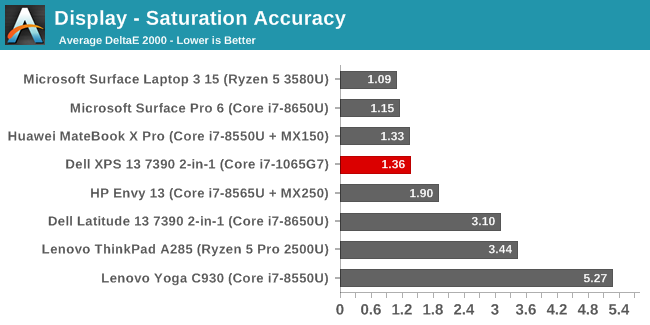
The saturation sweeps run all of the primary and secondary colors in 4-bit steps from 0% to 100% brightness. The results are nearly perfect, and well under the 3.0 level across the entire range on all six colors.
Gretag Macbeth
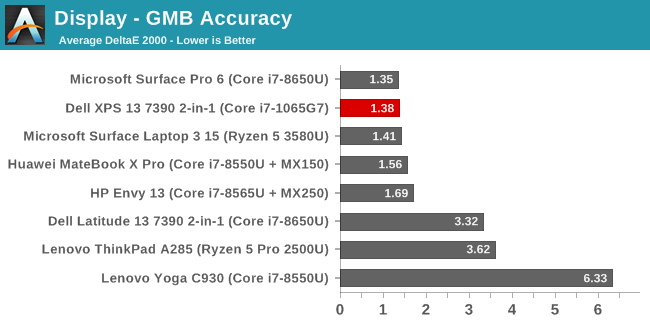
Our final test is the Gretag Macbeth, with tests a variety of colors outside of the primary and secondary axis, and including the important skin tones. None of the tested color points were really even over the 2.0 error level. This is a great result.
Colorchecker
This shows the relative error level with the target color on the bottom, and the displayed color on the top. Overall the results are near-perfect.
Display Conclusion
The XPS 13 offers one of the best displays on any notebook we’ve tested. The move back to the taller 16:10 aspect ratio is most welcome, and it’s been refreshing to see some manufacturers utilize taller displays such as the 3:2 and 16:10 when it used to be almost impossible to find anything that was not 16:9. The aspect is even more important when you consider this is a convertible laptop, and 16:9 does not work very well as a tablet.
Dell also offers an excellent anti-reflective coating, which will hopefully spur on their competitors to follow suit. This is something Apple’s iPad range has excelled at for some time, but many PCs still have either a matte coating to scatter the light, which also reduces the sharpness of the image, or very reflective glass coatings which are sharp but hard to use outside. The XPS 13 7390 offers both a very bright, and a low reflectivity coating, meaning it should excel in bright environments.
Finally, Dell has calibrated the display, meaning the colors on the XPS 13 are almost perfect.
This combination is a big win for the XPS 13, and provides it yet another area where it excels over its competition.















108 Comments
View All Comments
abufrejoval - Friday, November 15, 2019 - link
First impression: This sure doesn't disappoint!1900x1200 makes a ton of sense (4k at 13" much less to my eyes), real CPU performance is better than Whiskey without draining the bottle, GPU performance is where I expected from a Skylake Iris 550 notebook I own, physical design sounds great... Perhaps I'd wait for a Lenovo variant, because I do type a lot.
With the higher-resolution, touch screen and a pen I'm not sure I'd ever be able to get it back from my daughter who can paint for hours even on a 6" mobile phone.
The most welcome surprise seemed the price: $1500 for 16GB and an i7 seems downright reasonable for what is most likely the current high-end.
Alas, when I went into the local (EU) configurator and added 32GB RAM, that added €1000 for what is essentially a €50 item (16 GB SO-DIMM). Sure it also added a 1TB NVME (€100 total or another €50 for the delta) and a 4k display I don't care about, but at that point I can't but call it the usual rip-off: I like my 4k at 42" and storage to be replacable.
So I'll hold back and onto my Lenovo S730 (16GB RAM, 1TB Samsung, AX200) for €1200 in May a little longer. That one also has an additional USB-C port in addition to the two Thunderbolts and that turns out to be really useful day-to-day, especially if your (mini) TB dock doesn't supply power, too.
But I note with satisfaction that at least in the mobile space Intel is still able to execute and I wish them well, while I won't remotely consider any Intel while there is Rome in the datacentre.
MASSAMKULABOX - Wednesday, November 20, 2019 - link
I think these are priced for the Business Market .. and its "car" pricing .. the base model is surprisingly cheap, but when you addd satnav,better wheels, heated sunroof, upgraded stereo , you've added 50% to the price. But 1000 bux for RAM is a trick learned from Apple.And where does this leave NVidia going forwrd? All their BAse(models) belong to us.
IntelUser2000 - Friday, November 15, 2019 - link
I'm suspicious of Anandtech's battery life tests for laptops.This is the only review where it doesn't regress and does significantly better than the Whiskey Lake generation.
Icelake does really well on idle but on actual usage like web browsing it plummets. Perhaps its time for them to update their tests.
yeeeeman - Saturday, November 16, 2019 - link
Phoronix review of the same laptops gets to the conclusion that ice lake is more power efficient than 14nm parts in both idle and heavy use.timecop1818 - Saturday, November 16, 2019 - link
Soldered in Killer Wireless garbage again. Not buying another Dell ever until they switch that shit out. I don't care if its made by Intel these days as long as they keep promoting that retarded branding shit in their non-gamer laptops, they will not have my money.Reflex - Saturday, November 16, 2019 - link
Literally just install the Intel AX200 drivers. Took me 5 mins and works great.timecop1818 - Saturday, November 16, 2019 - link
PCI IDs are different, no?Reflex - Sunday, November 17, 2019 - link
Doesn't seem to be. It will tell you its the incorrect driver but once you force it it will install, and future driver updates via Intel's updater will pick them up and install without a question.timecop1818 - Sunday, November 17, 2019 - link
Yeah, that means it's a different PCI ID. Because if they were included in the intel driver inf that would install without forcing. Intel would prolly be PCI\VEN_8086*DEV_xxxx and killer stuff probably uses their own vendor ID. Anyway, I'm happy with my current gemcut spectre x360 which has better screen and keyboard than XPS 13 anyway.Reflex - Sunday, November 17, 2019 - link
I hear its a good laptop, it was on my list until I noticed it didn't have a 32GB of RAM option. They both appeal to slightly different requirements IMO and I'd recommend either depending on the user and what they need.